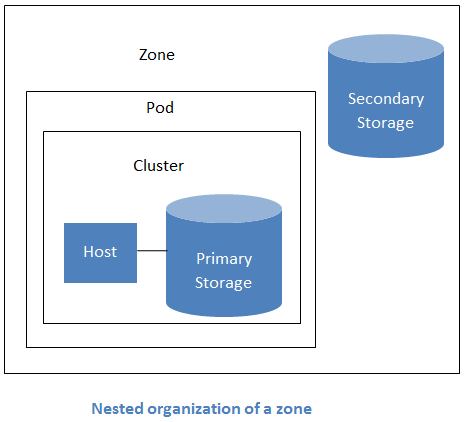A zone is the second largest organizational unit within a CloudStack deployment. A zone typically corresponds to a single datacenter, although it is permissible to have multiple zones in a datacenter. The benefit of organizing infrastructure into zones is to provide physical isolation and redundancy. For example, each zone can have its own power supply and network uplink, and the zones can be widely separated geographically (though this is not required).
A zone consists of:
One or more pods. Each pod contains one or more clusters of hosts and one or more primary storage servers.
A zone may contain one or more primary storage servers, which are shared by all the pods in the zone.
Secondary storage, which is shared by all the pods in the zone.
Zones are visible to the end user. When a user starts a guest VM, the user must select a zone for their guest. Users might also be required to copy their private templates to additional zones to enable creation of guest VMs using their templates in those zones.
Zones can be public or private. Public zones are visible to all users. This means that any user may create a guest in that zone. Private zones are reserved for a specific domain. Only users in that domain or its subdomains may create guests in that zone.
Hosts in the same zone are directly accessible to each other without having to go through a firewall. Hosts in different zones can access each other through statically configured VPN tunnels.
For each zone, the administrator must decide the following.
How many pods to place in each zone.
How many clusters to place in each pod.
How many hosts to place in each cluster.
(Optional) How many primary storage servers to place in each zone and total capacity for these storage servers.
How many primary storage servers to place in each cluster and total capacity for these storage servers.
How much secondary storage to deploy in a zone.
When you add a new zone using the CloudStack UI, you will be prompted to configure the zone’s physical network and add the first pod, cluster, host, primary storage, and secondary storage.
In order to support zone-wide functions for VMware, CloudStack is aware of VMware Datacenters and can map each Datacenter to a CloudStack zone. To enable features like storage live migration and zone-wide primary storage for VMware hosts, CloudStack has to make sure that a zone contains only a single VMware Datacenter. Therefore, when you are creating a new CloudStack zone, you can select a VMware Datacenter for the zone. If you are provisioning multiple VMware Datacenters, each one will be set up as a single zone in CloudStack.
If you are upgrading from a previous CloudStack version, and your existing deployment contains a zone with clusters from multiple VMware Datacenters, that zone will not be forcibly migrated to the new model. It will continue to function as before. However, any new zone-wide operations, such as zone-wide primary storage and live storage migration, will not be available in that zone.


